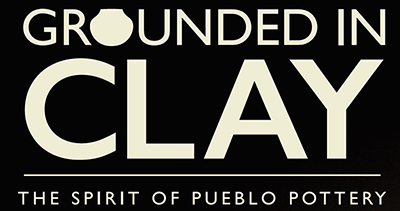Max Early
Laguna Pueblo
Curator Max Early received his MFA in Creative Writing (Poetry) from the Institute of American Indian Arts, Santa Fe, in 2020. He is a published poet and established potter from Laguna Pueblo.
Max chose the following for the Grounded in Clay exhibit:
Rarest Form of Pueblo Pottery
A necessity for every Pueblo home was a large bowl for mixing dough to bake loaves in the outside bread house, or ba-kadrutyu. Imagine the wear these vessels endured as water was poured into them, batter stirred, and dough mixed. Earthenware is more vulnerable to breakage than stoneware and porcelain. This type of earthenware dough bowl would have been expendable during the eighteenth and nineteenth centuries, and would have worn out after a few generations. A bowl was placed aside if it cracked, then ground into temper for additional pottery clay. Or the matriarch of a family could have requested that her dough bowl, as a cherished heirloom, be buried with her when she departed.
The vessel I chose to write about is a rare example, one that symbolizes perseverance. The first time I noticed the dough bowl was in the book Two Hundred Years of Historic Pueblo Pottery by Francis H. Harlow (1991). There, the vessel is identified as a Laguna polychrome dough bowl. Ever since then, I have been fascinated by the simplicity and boldness of its design, but until this project I did not have an opportunity to study the bowl in its entirety.
I have crossed paths with the dough bowl on four occasions. In the early 1990s, I often visited the bowl at a gallery in Santa Fe. It sold, changed owner, and was up for sale at another gallery, where I spotted it again. After it sold, I often wondered where it went. Then, in 2006, I walked into the Denver Public Library, and by chance I found my beloved treasure on display. At that point it was part of the Silverman Museum Collection. Fifteen years later, when I scanned through the Vilcek Foundation’s catalogue, I had no idea the dough bowl had become part of the Vilcek Collection. My eyes widened as I sensed the bowl calling out to me.
This pottery bowl was a delight to examine. As the pottery gravitated toward me and I toward it, I experienced a convergence of clay with the past and the present. It felt as if I had found a long-lost relative residing in New York, and we were reacquainted. I whispered a greeting in my Keres language and asked the spirit of the bowl to tell me more about itself. To the Pueblo people, their pottery vessels have lives as individual beings of creation.
I wrote an anaphoric poem based on the encounters I have had with the dough bowl. The stanzas explore the spirit of natural beauty and tenacity. I have personified the bowl in order to commemorate its longevity, as the pottery has blessed me with its presence and legacy.
Convergence of Clay
I see you in a pottery book with your maroon cactus petals.
I long to breathe your virtuosity then hold you in my palms.
I see you at Morning Star. Your vines curl in waves of faded beauty.
If I knew where you came from, I would take you there.
I see you in a headdress. Seven red-tipped feathers of sunrise
and sunset. I adore your resilient design on vintage skin.
I see you at a gallery. Your seasoned interior of vermilion
and beige reveals a footprint from infinite recipe blends.
I see you at the Denver Library, sitting atop a bookshelf.
The elevated stance displays your symmetry like a regal crest.
I see your reflection in a pond as bees caress your honeycomb.
A flight of stairs ascends on your painted cloudblanket motif.
I see you’re in another book of Pueblo treasures: the portrait
captures a glimpse of your durable longevity.
I don’t see you for over a decade, until I thumb through a file
of photos as your image entices my potter’s eye.
I know I’ll see you when I request your presence in Santa Fe.
Your flight from New York lands before the lockdown.
After a postponed year, I see your chafed mask of antiquity.
My hands embrace your rare and vigorous shape.
I see you don’t have a distinct spirit line. I’ll select a place
to cross your threshold of earthenware permanence.
I see your dough, rising for the adobe bread oven. Your generous
tasks of stirring, mixing, and serving food for feast days and dances.
I see your matriarch blend blue corn mush for ma-dzini—piki bread.
Her fingers slide batter from your bowl onto a flat sandstone griddle.
I see her filling your deep bowl with apples from the orchard.
The last harvest you’ll see prior to leaving your birthplace.
I see you were a kitchen heirloom, lonesome for your home.
Amuu’u dyuuni. Hitedâ shra-neesh dyáy-ya?
My compassion, pottery. Where have you been?

